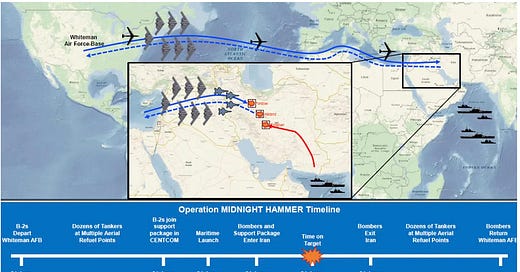In the dark hours of last night, the United States made military history and delivered a devastating message to the Islamic Republic of Iran. In a single, tightly coordinated mission named Operation Midnight Hammer, the U.S. executed a precision strike that may forever alter the trajectory of Iran’s nuclear ambitions.
Seven B-2 Spirit stealth bombers, flying from Whiteman Air Force Base in Missouri, crossed continents in an 18-hour flight with multiple in-flight refuelings. These aircraft, invisible to radar and unmatched in their global strike capabilities, dropped 14 GBU-57 Massive Ordnance Penetrators on Iran’s most heavily fortified nuclear facilities at Fordow and Natanz. This marked the first time the 30,000-pound GBU-57 bomb has ever been used in combat. Simultaneously, two dozen Tomahawk cruise missiles struck surface targets at Esfahan in a wave of kinetic precision that formed the opening salvo of the assault. In total, 75 precision-guided munitions slammed into Iran's nuclear infrastructure with overwhelming force.
The B-2 bombers that attacked flew from Missouri. It was an 18-hour flight with multiple in-flight refuels.
Operation Midnight Hammer relied on exact synchronization and minimal communication as the package flew to their targets. At 5 pm, two dozen Tomahawk cruise missiles were launched at surface targets at Esfahan. Decoys and a protection package of fourth and fifth generation (F-35) fighter jets swept and cleared the way for the B-2 bombers. The total operation involved 125 aircraft. The Tomahawks that were in flight the entire time hit only after the B-2s had struck Fordow and Natanz.
No Iranian shots were fired at any of the package. Iran’s fighter jets did not fly and Iran’s surface-to-air systems appear to have not even seen the package. Iranian air defenses never fired. Not a single fighter jet scrambled. The radar-evading strike force effectively disappeared into and out of Iranian skies without resistance.
This was not about starting a war. It is about ending one by pushing the Islamic regime closer to realizing it must give up their nuclear program, which remains the single clear objective of the war, to end decades of failed diplomatic and economic measures to prevent Iran from building a nuclear weapon. The United States had to assist Israel with capabilities like the GBU-57 to destroy Iranian infrastructure and push toward the only real solution: Iran giving up their nuclear program. Now it is up to Iran’s leadership, but President Trump has ensured that Iran will not be able to achieve a nuclear weapon during his tenure.
We now await full battle damage assessments of the three sites struck, especially Fordow, which lies buried deep beneath a mountain. But without a doubt, the United States did what no other country could in damaging Iran’s nuclear program deep underground. This action joins Israel’s historic operations that include the elimination of over 14 high-ranking nuclear scientists and many parts of Iran’s nuclear weapon pursuit, from missile assembly to uranium and plutonium enrichment sites. The combined effect is a massive strategic blow to Iran’s long-running efforts to build a nuclear bomb.
The first ever use of the 30,000-pound GBU-57 weapon has been used in war. This was the largest B-2 stealth bomber operational strike in history and the second longest B-2 bomber flight ever flown, only second to those following 9/11.
The United States is not at war with Iran. The United States has not declared war on Iran. The United States did use military force to assist Israel in achieving a limited goal to dismantle Iran’s nuclear program. A few voices have criticized President Trump for not getting congressional authorization before attacking Iran, but they are overlooking the historical record that since World War II, 99 percent of the time U.S. presidents have used military force it was without explicit prior approval from Congress.
Last night was not just a military achievement. It was a strategic message written in steel, silence, and sky. The era of delay and denial is over. The world has changed. Iran’s path to the bomb has been shattered, and the consequences of rebuilding it will now come at a cost they can no longer afford.
John Spencer is executive director of the Urban Warfare Institute.
He is the coauthor of Understanding Urban Warfare
Learn more at www.johnspenceronline.com
You can also follow him on 'X' at: @SpencerGuard
Substack: https://substack.com/@spencerguard
The views expressed in this article are the writer's own.




I hope that the strike was successful. But I wonder if they have a few completed or partially completed weapons hidden somewhere. But even if this were the case, these facilities were part of the industrial complex required to manufacture a large number of these weapons and refine them long term.
The Iranian Government has spent enormously on this program as well as the build up of their proxies in Hamas and Hezbollah.
Over the last year that investment has pretty much gone down the drain.
Maybe it didn’t change everything
Early US intel assessment suggests strikes on Iran did not destroy nuclear sites, sources say
https://www.cnn.com/2025/06/24/politics/intel-assessment-us-strikes-iran-nuclear-sites